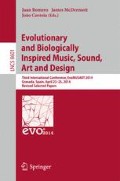Abstract
We present a novel, real-time system, called Harmonic Navigator, for exploring the harmonic space in J.S. Bach Chorales. This corpus-based environment explores trajectories through harmonic space. It supports visual exploration and navigation of harmonic transition probabilities through interactive gesture control. These probabilities are computed from musical corpora (in MIDI format). Herein we utilize the 371 J.S. Bach Chorales of the Riemenschneider edition. Our system utilizes a hybrid novelty search approach combined with power-law metrics for evaluating fitness of individuals, as a search termination criterion. We explore how novelty search can aid in the discovery of new harmonic progressions through this space as represented by a Markov model capturing probabilities of transitions between harmonies. Our results demonstrate that the 371 Bach Chorale harmonic space is rich with novel aesthetic possibilities, possibilities that the grand master himself never realized.
Access this chapter
Tax calculation will be finalised at checkout
Purchases are for personal use only
Preview
Unable to display preview. Download preview PDF.
References
Cope, D.: Virtual Music: Computer Synthesis of Musical Style. MIT Press, Cambridge (2004)
Eigenfeldt, A., Pasquier, P.: Realtime Generation of Harmonic Progressions Using Controlled Markov Selection. In: 1st International Conference on Computational Creativity (ICCC-X), pp. 16–25. ACM Press, New York (2010)
Legname, O.: Density Degree of Intervals and Chords. 20th Century Music 4(11), 8–14 (1997)
Lehman, J., Stanley, K.: Abandoning Objectives: Evolution through the Search for Novelty Alone. Evolutionary Computation Journal 19(2), 189–223 (2011)
Manaris, B., Romero, J., Machado, P., Krehbiel, D., Hirzel, T., Pharr, W., Davis, R.B.: Zipf’s Law, Music Classification and Aesthetics. Computer Music Journal 29(1), 55–69 (2005)
Manaris, B., Roos, P., Machado, P., Krehbiel, D., Pellicoro, L., Romero, J.: A Corpus-Based Hybrid Approach to Music Analysis and Composition. In: 22nd Conference on Artificial Intelligence (AAAI 2007), pp. 839–845. AAAI Press, Palo Alto (2007)
Manaris, B., Hughes, D., Vassilandonakis, Y.: Monterey Mirror: Combining Markov Models, Genetic Algorithms, and Power Laws. In: 1st Workshop in Evolutionary Music, 2011 IEEE Congress on Evolutionary Computation (CEC 2011), pp. 33–40. IEEE Press, Piscataway (2011)
Manaris, B., Johnson, D., Vassilandonakis, Y.: Harmonic Navigator: A Gesture-Driven, Corpus-Based Approach to Music Analysis, Composition, and Performance. In: 2nd International Workshop on Musical Metacreation (MUME 2013), 9th AAAI Conference on Artificial Intelligence and Interactive Digital Entertainment, pp. 67–74. AAAI Press, Palo Alto (2013)
Johnson, D., Manaris, B., Vassilandonakis, Y.: Harmonic Navigator: An Innovative, Gesture-Driven User Interface for Exploring Harmonic Spaces in Musical Corpora. In: Kurosu, M. (ed.) HCI 2014, Part II. LNCS, vol. 8511, pp. 58–68. Springer, Heidelberg (2014)
Manaris, B., Roos, P., Krehbiel, D., Zalonis, T., Armstrong, J.R.: Zipf’s Law, Power Laws and Music Aesthetics. In: Li, T., Ogihara, M., Tzanetakis, G. (eds.) Music Data Mining, pp. 169–216. CRC Press, Boca Raton (2011)
Pachet, F.: Beyond the Cybernetic Jam Fantasy: The Continuator. IEEE Computer Graphics and Applications 24(1), 31–35 (2004)
Rosen, C.: The Classical Style; Haydn, Mozart, Beethoven, p. 26. W.W. Norton & Co., New York (1971)
Schoenberg, A.: Structural Functions of Harmony, pp. 192–196. W.W. Norton & Co., New York (1954)
Author information
Authors and Affiliations
Editor information
Editors and Affiliations
Rights and permissions
Copyright information
© 2014 Springer-Verlag Berlin Heidelberg
About this paper
Cite this paper
Manaris, B., Johnson, D., Vassilandonakis, Y. (2014). A Novelty Search and Power-Law-Based Genetic Algorithm for Exploring Harmonic Spaces in J.S. Bach Chorales. In: Romero, J., McDermott, J., Correia, J. (eds) Evolutionary and Biologically Inspired Music, Sound, Art and Design. EvoMUSART 2014. Lecture Notes in Computer Science, vol 8601. Springer, Berlin, Heidelberg. https://doi.org/10.1007/978-3-662-44335-4_9
Download citation
DOI: https://doi.org/10.1007/978-3-662-44335-4_9
Publisher Name: Springer, Berlin, Heidelberg
Print ISBN: 978-3-662-44334-7
Online ISBN: 978-3-662-44335-4
eBook Packages: Computer ScienceComputer Science (R0)

